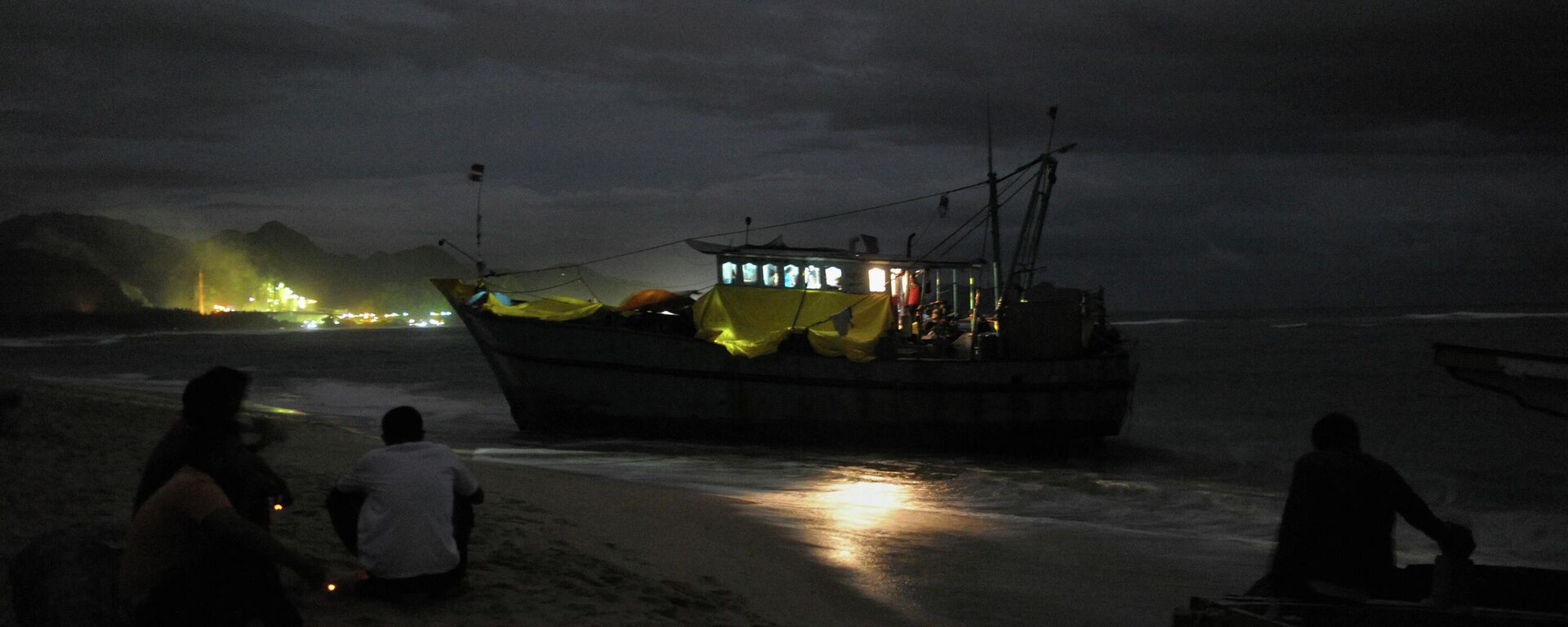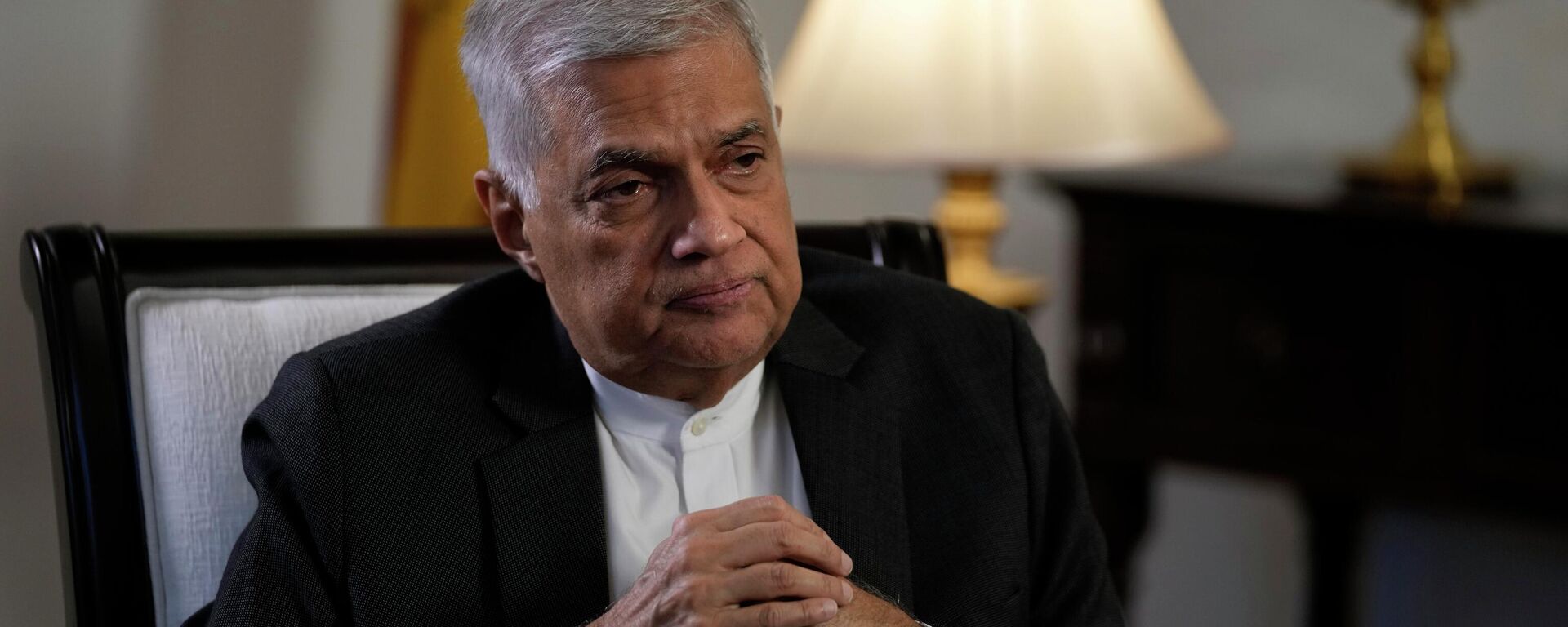https://sputnikglobe.com/20220624/sri-lankas-economic-crisis-fuels-new-wave-of-migration-as-hundreds-opt-for-dangerous-sea-voyages-1096613271.html
Sri Lanka’s Economic Crisis Fuels New ‘Wave’ of Migration as Hundreds Opt for Dangerous Sea Voyages
Sri Lanka’s Economic Crisis Fuels New ‘Wave’ of Migration as Hundreds Opt for Dangerous Sea Voyages
Sputnik International
Sri Lankan PM Ranil Wickremesinghe told his parliament this week that the economy has “collapsed” and the government was unable to buy crude supplies, with... 24.06.2022, Sputnik International
2022-06-24T07:05+0000
2022-06-24T07:05+0000
2022-10-19T18:35+0000
sri lanka
australia
ranil wickremesinghe
gotabaya rajapaksa
crude oil
imf
refugees
asylum seeker
analysis
opinion
https://cdn1.img.sputnikglobe.com/img/07e6/06/18/1096617954_0:320:3072:2048_1920x0_80_0_0_185c01b2855e2608d7d968d714211173.jpg
Hundreds of Sri Lankan Tamils have tried to undertake dangerous sea journeys to Australia, India and towards Africa since May, amid another “wave” of migrants wanting to leave the South Asian nation as it battles its worst economic crisis since 1948.Members of the Sri Lankan Tamil community have told Sputnik that most of those wanting to leave the country by sea belong to the Tamil community, which is concentrated in the northern and eastern parts of the country.Since last month, the Sri Lankan Navy has intercepted hundreds of fishing trawlers, which were caught illegally carrying migrants from northern and eastern cities to Australia, India and even “western waters”, as per official statements.The Australian Border Force (ABF) said last month that it had intercepted a Sri Lankan vessel with ‘illegal maritime arrivals (IMAs)’, the first in several years.Overall, Sri Lankan and Australian authorities say that four boats bound for Australia from the south Asian nation have been stopped and turned back in the last five weeks.According to a report in the Indian news agency IANS, around 90 Sri Lankan Tamils have landed on India’s southern coast, through the beginning of the fuel and food shortages in April and last week.Two Sri Lankan Tamil families, comprising seven people, illegally migrated to the southern coastal town of Dhanushkodi last week. Meanwhile, the Department of Immigration and Emigration of Sri Lanka has told local media that it has issued more than 300,000 new passports in the first five months of this year. Just around 100,000 new passports were issued last year.Earlier this month, Sri Lanka’s Bureau of Foreign Employment said that more than 120,000 people had left for overseas jobs in the first five months this year, a 100 percent spike compared to the same period last year.Vigetharan is currently a research scholar in political science at Annamalai University. He has authored two Tamil language books about the life of Tamil refugees in India—Yeethili (Refugee in Tamil) and Kruthi Vazhiyum Padal (the song of blood).He came to India in 1998 after, like many others, being caught in violence between the banned ethnic separatist group Liberation Tigers of Tamil Eelam (LTTE) and Sri Lankan forces.He explains that Sri Lankan Tamils have fled the violence and persecution in four different ‘waves’—first between 1983 and 1987, from 1990 to 1991, between 1995 and 2002 and then between 2009 and 2013.The last phase of exodus coincided with the final stages of the war against the Liberation Tigers of Tamil Eelam (LTTE), a 26-year-old insurgency that ended in 2009.Vigetharan says he is still in touch with friends and relatives back home, many of whom “desperately” want to leave.Dr. Maravanpulavu Sachithananthan, who heads the Jaffna-based Hindu Tamilian group Siva Senai, accused the Sri Lankan military of not allowing the Tamils in the northern and eastern parts of the country to vent out their frustration against the ongoing shortages, while public outcry is allowed in Colombo and Galle. According to reports in Sri Lankan media, the military has allegedly opened fire at protestors during the ongoing economic crisis. In an incident reported last weekend in northern Visuvamadu, a town located 360 kilometers from Colombo, the military reportedly fired at angry protestors at a petrol pump after it ran out of fuel.Unofficial Inflation in Sri Lanka is Over 100 Percent, Claims NonprofitSinnathamby Sooriyakumary, the President of OfERR Ceylon, which runs camps in both Sri Lanka and India, told Sputnik that the “high cost of living” has made it difficult for low and middle-income households to sustain themselves.She further says that countrywide power cuts have had a direct bearing on the unemployment situation, with many industrial units entirely shutting down or working below capacity, with reduced workforce.The International Labor Organization (ILO) estimates that around a quarter of Sri Lanka’s population is involved in activities like farming and fishing. According to some estimates, around 70 percent of the rural population is engaged in these activities, which have bore the double whammy of a post-economic COVID slowdown and now the economic crisis.According to the UN-backed World Food Program (WFP), around five million Sri Lankans have been left “food insecure” due to the crisis and some are “skipping meals” altogether. Overall, 86 percent of Sri Lankan households are “eating less” due to the crisis.The WFP also estimates that half a million Sri Lankans have been pushed into poverty or hunger due to the crisis.Other groups have further warned that the ongoing negotiations between the Sri Lankan government and the International Monetary Fund (IMF) for a bailout package could result in government austerity measures that could adversely affect the vulnerable sections.
https://sputnikglobe.com/20220623/australian-opposition-blasts-govt-over-surging-boat-arrivals-from-sri-lanka---report-1096582638.html
https://sputnikglobe.com/20220622/sri-lanka-hopes-to-seal-imf-deal-by-july-as-pm-outlines-revival-plan-of-collapsed-economy-1096551475.html
sri lanka
australia
Sputnik International
feedback@sputniknews.com
+74956456601
MIA „Rosiya Segodnya“
2022
News
en_EN
Sputnik International
feedback@sputniknews.com
+74956456601
MIA „Rosiya Segodnya“
Sputnik International
feedback@sputniknews.com
+74956456601
MIA „Rosiya Segodnya“
sri lanka, australia, ranil wickremesinghe, gotabaya rajapaksa, crude oil, imf, refugees, asylum seeker, analysis, opinion
sri lanka, australia, ranil wickremesinghe, gotabaya rajapaksa, crude oil, imf, refugees, asylum seeker, analysis, opinion
Sri Lanka’s Economic Crisis Fuels New ‘Wave’ of Migration as Hundreds Opt for Dangerous Sea Voyages
07:05 GMT 24.06.2022 (Updated: 18:35 GMT 19.10.2022) Sri Lankan PM Ranil Wickremesinghe told his parliament this week that the economy has “collapsed” and the government was unable to buy crude supplies, with final stocks running out this week. The fuel and food shortage has hit the low and middle income groups pretty hard, with many fleeing the country using both legal and illegal means.
Hundreds of Sri Lankan Tamils have tried to undertake dangerous sea journeys to Australia, India and towards Africa since May, amid another “wave” of migrants wanting to leave the South Asian nation as it battles its
worst economic crisis since 1948.
Members of the Sri Lankan Tamil community have told Sputnik that most of those wanting to leave the country by sea belong to the Tamil community, which is concentrated in the northern and eastern parts of the country.
While "immigration agents" charge around $800 for a trip to India, the cost for such a voyage to Australia is around $4,000, a voyage that takes up to 21 days. The trips are arranged on "unseaworthy fishing vessels," people familiar with the matter have said.
Since last month, the Sri Lankan Navy has intercepted hundreds of fishing trawlers, which were caught illegally carrying migrants from northern and eastern cities to Australia, India and even “western waters”, as per official statements.
The Australian Border Force (ABF) said last month that it had intercepted a Sri Lankan vessel with ‘illegal maritime arrivals (IMAs)’, the first in several years.
Overall, Sri Lankan and Australian authorities say that four boats bound for Australia from the south Asian nation have been stopped and turned back in the last five weeks.
According to a report in the Indian news agency IANS, around 90 Sri Lankan Tamils have landed on India’s southern coast, through the beginning of the fuel and food shortages in April and last week.
Two Sri Lankan Tamil families, comprising seven people, illegally migrated to the southern coastal town of Dhanushkodi last week.
Meanwhile, the Department of Immigration and Emigration of Sri Lanka has told local media that it has issued more than 300,000 new passports in the first five months of this year. Just around 100,000 new passports were issued last year.
Earlier this month, Sri Lanka’s Bureau of Foreign Employment said that more than 120,000 people had left for overseas jobs in the first five months this year, a 100 percent spike compared to the same period last year.
“We are witnessing yet another wave of exodus of Sri Lankans wanting to leave the country through legal and illegal means,” A.S Vigetharan, a Sri Lankan Tamil refugee living in the southern Indian metropolis of Chennai, tells Sputnik.
Vigetharan is currently a research scholar in political science at Annamalai University. He has authored two Tamil language books about the life of Tamil refugees in India—Yeethili (Refugee in Tamil) and Kruthi Vazhiyum Padal (the song of blood).
He came to India in 1998 after, like many others, being caught in violence between the banned ethnic separatist group Liberation Tigers of Tamil Eelam (LTTE) and Sri Lankan forces.
“What’s different this time around is that even Sinhala Buddhists are leaving through legal means,” he claims.
He explains that Sri Lankan Tamils have fled the violence and persecution in four different ‘waves’—first between 1983 and 1987, from 1990 to 1991, between 1995 and 2002 and then between 2009 and 2013.
The last phase of exodus coincided with the final stages of the war against the Liberation Tigers of Tamil Eelam (LTTE), a 26-year-old insurgency that ended in 2009.
Vigetharan says he is still in touch with friends and relatives back home, many of whom “desperately” want to leave.
“For Sri Lankan Tamils in particular, there is no future left in Sri Lanka. The economic crisis has taken away whatever little hope we had left from the post-war reconciliation process,” he argues.
Dr. Maravanpulavu Sachithananthan, who heads the Jaffna-based Hindu Tamilian group Siva Senai, accused the Sri Lankan military of not allowing the Tamils in the northern and eastern parts of the country to vent out their frustration against the ongoing shortages, while public outcry is allowed in Colombo and Galle.
According to reports in Sri Lankan media, the military has allegedly opened fire at protestors during the ongoing economic crisis. In an incident reported last weekend in northern
Visuvamadu, a town located 360 kilometers from Colombo, the military reportedly fired at angry protestors at a petrol pump after it ran out of fuel.
Unofficial Inflation in Sri Lanka is Over 100 Percent, Claims Nonprofit
Sinnathamby Sooriyakumary, the President of OfERR Ceylon, which runs camps in both Sri Lanka and India, told Sputnik that the “high cost of living” has made it difficult for low and middle-income households to sustain themselves.
“Official inflation is over 40 percent (according to the Department of Census and Statistics), but unofficially it is over 100 percent,” she reckoned, citing the scarce availability of fuel and food.
She further says that countrywide power cuts have had a direct bearing on the unemployment situation, with many industrial units entirely shutting down or working below capacity, with reduced workforce.
“The fuel crisis has affected the livelihoods of the people. Activities such as farming and fishing, which relied on kerosene, are no longer feasible,” she says.
The International Labor Organization (ILO) estimates that around a quarter of Sri Lanka’s population is involved in activities like farming and fishing. According to some estimates, around 70 percent of the rural population is engaged in these activities, which have bore the double whammy of a post-economic COVID slowdown and now the economic crisis.
According to the UN-backed
World Food Program (WFP), around five million Sri Lankans have been left “food insecure” due to the crisis and some are “skipping meals” altogether. Overall, 86 percent of Sri Lankan households are “eating less” due to the crisis.
The WFP also estimates that half a million Sri Lankans have been pushed into poverty or hunger due to the crisis.
Other groups have further warned that the ongoing negotiations between the Sri Lankan government and the International Monetary Fund (IMF) for a bailout package could result in government
austerity measures that could adversely affect the vulnerable sections.
“Amnesty International is particularly concerned that the government’s response to the crisis may result in a further erosion of economic and social rights,” the London-headquartered human rights watchdog said in a statement on 20 June.






